
Motto
...Forever the traveller and the wanderer, I always found Iaşi to be a restful place to stop by (...). I remember its cheerfulness as being entirely intellectual, presided over by the icon of my literary friends, gathered in debates and readings (...). A day spent in Iaşi was for me a discreet and finely nuanced celebration. In Iaşi I felt closer than elsewhere to the ideal place where everyone would like to spend their life. There was, in this royal city, enveloped in the melancholy of unbearably grand memories, more wit and more worship of all things intellectual than in any other Romanian centre..." (Gala Galaction – "Iasii-as they were")
About Iasi
Iasi is the most important political, economic and cultural centre of Moldavia and one of the oldest cities in Romania. Situated in the North-East of Romania, between the Moldavian Plateau and the Jijia Plain, on the River Bahlui, it used to be the crossroads place of the commercial routes that passed through Moldavia coming from Poland, Hungary, Russia and Constantinopole.
Archaelogical investigations attest the presence of human communities on the present territory of the city and around it as far back as the prehistoric age. But the beginnings of urban life in lasi are to be found in the second half of the 14th century, the name of the city being mentioned for the first time in a document about commercial privilege granted by the Moldavian ruler Alexandru cel Bun to the Polish merchants of Lvov in 1408.
Major events in the political and cultural history of Moldavia are connected with the name of the city of Iasi. Thus it is here that we can trace the roots of the Romanian national historiography. The great scholars of the 17th century - "the golden age" of Romanian culture - namely Grigore Ureche, Miron Costin and later Ion Neculce, wrote most of their works in the city or not far from it and the famous scholar Dimitrie Cantemir known throughout all Europe also linked his name to the capital of Moldavia.
At the beginning of the 19th century, the many-sided scholar Gheorghe Asachi laid the foundation of the national school in the Romanian language and, in 1829, he published the first newspaper in Romanian. And it was also here that the first superior institute in the country was founded in 1835.
This same town was the place where Alexandru loan Cuza was elected ruler of Moldavia (January 5th, 1859), the first step in fulfilling the Romanians' desire of forming a single unified country named Romania.
Iasi continued to be the most important cultural centre of the country even after Bucharest became the capital of Romania in 1862. It is in Iasi that the first Romanian university was founded in 1860, during the reign of Alexandru Ioan Cuza, and in 1867 there appeared the "Convorbiri literare" review in which Ion Creangă’s "Memories from My Boyhood" and the best poems by Mihai Eminescu, the "Morning Star" of Romanian poetry, were published. The reviews "Contemporanul" and "Viata românească” appeared in 1871, respectively in 1906, and had a great contribution to promoting our national cultural values.
Many great personalities of Romanian culture are connected to Iasi: the chronicler Nicolae Milescu, the historian and political man Mihail Kogălniceanu, the poet Vasile Alecsandri, the writer Mihail Sadoveanu, the poet George Topârceanu, the writer Alecu Russo, the writer Ionel Teodoreanu, the literary critic Titu Maiorescu, the chemist Petru Poni, the historian A.D. Xenopol, the philosopher Vasile Conta, the sociologist Dimitrie Gusti, the geographer Emil Racoviţă the philosopher Petru Andrei, the painter Octav Băncilă and many others.
Iasi, "the city of great loves", represents a symbol of Romanian history about which Nicolae lorga rightly said "there should be no Romanian who does not know it".
Called “the city on seven hills”, Iasi enjoys not only a nice relief and climate, but also a special social ambient: stately historical monuments, 500-year-old churches and monasteries, contemporary architecture… all ages have left their spiritual mark upon the city. With over 350,000 inhabitants, the city of Iasi is the capital of the County of Iasi and also of the whole Moldavian region. Characterised by the presence of an active population, by a high number of students (over 80,000), the city is equipped with all the facilities and services inherent to a regional metropolis: an important transportation network, good administration, hospitals, high quality cultural and sports centres, restaurants, festivals etc.


Iasi - Cultural Capital of Romania
The city of Iasi is famous as a cultural city, as it hosts important monuments of the spiritual history of Romania, and at the same time this is the place where tradition thrives and is very much alive.
"Alexandru Ioan Cuza" University
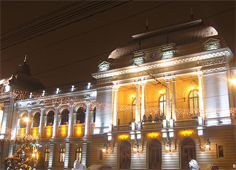
It is the first university in Romania and it was founded by Al.I.Cuza with the help of Mihail Kogalniceanu, in 1860.
The today’s headquarters of the university was inaugurated on 21 October 1897 in the presence of King Carol I and Queen Elizabeth. The building, a mixture of the Classical and Baroque styles, houses the famous “Hall of the Lost Footsteps” where one can admire the works of the painter Sabin Balasa.
Museums
The Palace of Culture
The Palace of Culture was built during 1906-1925 and it is the most important creation of the Romanian architect I. D. Berindei. It was inaugurated in 1926 in the presence of King Ferdinand Hohenzollern. The central tower has a clock with three frames, each one of 3,25 m diameter and a carillon that plays the “Hora Unirii”.
The building served as headquarters of the Administrative and Justice Palace until 1955.
Today it houses four museums: the Moldavian History Museum, the Science and Technology Museum, the Art Museum, the Moldavian Ethnography Museum.
“Mihai Eminescu” Museum
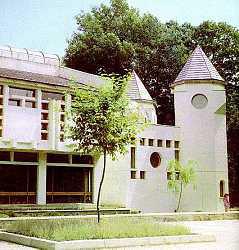
“Mihai Eminescu” Museum is situated in Copou Park and it is dedicated to the great poet’s life and creation.
The building has three rooms: the Room of destiny, the Art room and the Friendship’s room. The book collection includes editions of Eminescu’s work from the first editions since recent ones, monographic studies concerning the poet’s life, critical exegesis and translations of Eminescu’s poems in foreign languages. The “Mihai Eminescu”photos collection includes original samples and photocopies of all the photos regarding the life and activity of Eminescu. The museum’s art collection includes paintings, graphics and sculpture referring to Eminescu and his works.
Dosoftei House
 Dosoftei House is a building from the second half of the 17th century in which in 1679, the metropolitan bishop Dosoftei settled the second typography in Moldavia. With three facades, arched and right-angled windows, the edifice was restored between 1966-1969. Here the department of old literature of the Romanian Literature Museum was opened in 1970. Among the important pieces of the museum, we can count: a Slavonian manuscript from the 14th century (1350-1380), a Missal printed by Macarie in 1508 (the first Romanian printing), the oldest copies of the Moldavia’s Chronicles written by Grigore Ureche and Miron Costin, the Homily of the metropolitan bishop Varlaam (the first printing in Moldavia), the Psalter (1673) of the metropolitan bishop Dosoftei and a 1682 Gospel of the same bishop.
Dosoftei House is a building from the second half of the 17th century in which in 1679, the metropolitan bishop Dosoftei settled the second typography in Moldavia. With three facades, arched and right-angled windows, the edifice was restored between 1966-1969. Here the department of old literature of the Romanian Literature Museum was opened in 1970. Among the important pieces of the museum, we can count: a Slavonian manuscript from the 14th century (1350-1380), a Missal printed by Macarie in 1508 (the first Romanian printing), the oldest copies of the Moldavia’s Chronicles written by Grigore Ureche and Miron Costin, the Homily of the metropolitan bishop Varlaam (the first printing in Moldavia), the Psalter (1673) of the metropolitan bishop Dosoftei and a 1682 Gospel of the same bishop.
The Union Musem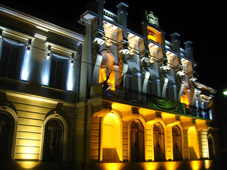
The building in which the Union Museum has its headquarters was built at the beginning of the 19th century. The palace served as the royal residence of Prince Al.I.Cuza between 1859-1862. In 1917-1918, during the first World War, here was the royal residence of king Ferdinand.
The Union Museum was opened in 1959, when they celebrated 100 years since the Union in 1859.
The museum’s patrimony includes original pieces and documents of extraordinary value which belonged to prince Al.I.Cuza and his family.
Pogor House
It houses the Romanian Literature Museum in Iasi. The edifice was built in 1850 by the High Steward Vasile Pogor and his wife, Zoe.
Casa Pogor has a rich history linked to Iasi cultural life, being a meeting place for the city intellectuals, the headquarters of Literary Society “Junimea” (1863) and of the “Literary Interlocutions” magazine (1867).
Memorial Houses
Ion Creanga ”Cottage”
It is the first memorial literature museum in Romania, inaugurated in April 1918. Here the great writer Ion Creanga lived between 1872-1889 and here he wrote his entire work. It has two rooms and a vestibule and contains Creanga’s writing materials and personal effects. Between 1984-1989, in the garden, a small amphitheatre was built for the celebration of traditional customs.
”Mihail Sadoveanu” Memorial House
The building situated on Copou Hill belonged to M.Kogalniceanu. In this house, between 1919-1947, the great prose writer Mihail Sadoveanu lived. In 1947 he donated his Copou property to the Agronomic Institute from Iasi.
On the first Sunday in May, “Lilac’s celebration” is organized here every year. “Mihail Sadoveanu” museum was inaugurated on 6th November 1980.
Churches & Monasteries
The Metropolitan Cathedral
 Bishop Veniamin Costache is the one who had the idea of building in Iasi a monumental church. The plan for this church was designed by the architects Johann Freywald and Bucher. The works took place first between 1833-1839 and then between 1880-1887, this time following the plans of the Romanian architect, Alexandru Orascu. The painting of the cathedral was done by Gheorghe Tattarescu.
Bishop Veniamin Costache is the one who had the idea of building in Iasi a monumental church. The plan for this church was designed by the architects Johann Freywald and Bucher. The works took place first between 1833-1839 and then between 1880-1887, this time following the plans of the Romanian architect, Alexandru Orascu. The painting of the cathedral was done by Gheorghe Tattarescu.
It was inaugurated on 23April 1887, at this event also taking part King Carol I and Bishop Iosif Naniescu.
In 1889 the relics of Saint Paraschiva were brought from Three Hierarchs Church to the new cathedral.
Barboi Church 
Barboi Church was built between 1841-1844 on the foundation of an old church dating from 1615. The Byzantine interior was built from rock and brick. The portico, held by Doric columns, is created in Classical style, while the spire presents neo-Gothic Roman elements. Because of its form and dimensions, Barboi Church is the Moldavian replica of some similar buildings on Mount Athos.
Writer Alecu Russo and sovereign Ioan Sandu Sturdza were buried in the church’s court, and in the tower was found the library of writer Costache Conachi. At this church Ion Creanga was curate during 1863-1865.
Golia Monastery
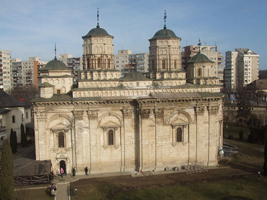 Old foundation from the 16 century of chancellor Ioan Golia, the church was restored at other dimensions by sovereign Vasile Lupu between 1650-1653 and finished by his son, Stefanita Voda.
Old foundation from the 16 century of chancellor Ioan Golia, the church was restored at other dimensions by sovereign Vasile Lupu between 1650-1653 and finished by his son, Stefanita Voda.
The monastery is surrounded by a high wall, with spires at the corners raised in 1667 and a steeple tower restored in 1900.
The tower of Golia is 30 m height. The visitor who wants to have a panorama of the city has to climb 120 stairs. The tower is one of city’s symbols.
During 1943-1947 restoration works took place at Golia, the monastery’s church being reopened after that.
In 1955, in two rooms on the Eastern part of the precinct, “Creanga” Museum was inaugurated, with documentary materials regarding the life of the great writer which was curate of monastery’s church.
Cetatuia Monastery
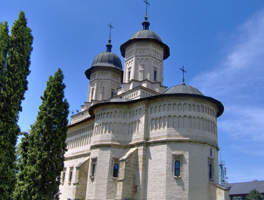
Cetatuia Monastery was built by sovereign Gheorghe Duca between 1669-1672. At the beginning, the church was surrounded by high rock walls, with bulwarks and a guard road, entrance and corner towers.
What makes Cetatuia unique is that it has maintained the whole ensemble of monastic architecture. On the Southern part of the precinct stands the Gothic Room “Doamna Anastasia”. The royal palace is a fortified building from the 17 century. The steeple tower and the massiveness of the walls are proving the fact that the monastery was conceived also as a refuge place, being in case of need, a real fortress.
The monastery’s church is specific for the religious Moldavian architecture of the 17century.
The monastic ensemble which was restored in the inter-war period at Nicolae Iorga’s request also includes a museum with numerous religious objects.
"Three Hierarchs" Monastery
 “Three Hierarchs” Monastery is the most beautiful foundation of sovereign of Vasile Lupu, prince of Moldavia, built between 1637-1639.
“Three Hierarchs” Monastery is the most beautiful foundation of sovereign of Vasile Lupu, prince of Moldavia, built between 1637-1639.
During 1882-1904 restoration works took place under the supervision of the French architect Lecomte de Nouy. The exterior decorations completely covering the building were gilded at the beginning, and combine Turkish, Arab, Georgian, Armenian and Persian elements with Romanian architectural motives in a wonderful rock lace. Over 30 registers of decorative motifs can be noticed.
Inside the monastery, members of Vasile Lupu’s family, Dimitrie Cantemir and Alexandru Ioan Cuza are buried.
Galata Monastery
The church was built between 1579-1584 by prince Petre Schiopul. The first church of the monastery was ruined after a short time, this fact determining the founder to build a second church on the hill dominating Nicolina river valley, in 1583. As regards the name of the monastery, some historians believe that it comes from the name of Galata neighbourhood in Constantinople. The interior painting was destroyed in 1762 during a blaze and it was repainted in 1811 by Vasile Dubrovski. The palace founded by Petru Schiopu was kept in the monastery’s precinct in a good form after the restoration.
The Great Synagogue
It was built between 1659-1670, is the oldest of Jewish praying houses in Romania. If in exterior it is very simple, without any decorations, the interior is as sophisticated as possible, decorated and gifted with valuable objects: chandeliers, candlesticks.
Hadambu Monastery 
Situated in Mogosesti, at 30 km south-west from Iasi, it was founded by Iani Hadimbul in 1959 on a place donated to him by sovereign Gheorghe Ghica. After a long period of being closed, the monastery was reopened in 1990.
The Catholic Cathedral
 The building of the old cathedral was first built from wood in 1753, on the place of an older church. Between 1782-1789, the church was rebuilt from brick and it remained so until these days. By the time, it suffered some restoration works, especially after the 1802’s earthquake and the blaze in 1827. In 1861, at the initiative of bishop Iosif Salandri, some new works of restoration and extension were made and the interior of the church was painted by Giuseppe Carta from Palermo. White marble altars and via cruces icons were also brought. Today, near the old cathedral, one can see a new church, a very modern building, circular and which has in its central part an oblong spire finished by a cross.
The building of the old cathedral was first built from wood in 1753, on the place of an older church. Between 1782-1789, the church was rebuilt from brick and it remained so until these days. By the time, it suffered some restoration works, especially after the 1802’s earthquake and the blaze in 1827. In 1861, at the initiative of bishop Iosif Salandri, some new works of restoration and extension were made and the interior of the church was painted by Giuseppe Carta from Palermo. White marble altars and via cruces icons were also brought. Today, near the old cathedral, one can see a new church, a very modern building, circular and which has in its central part an oblong spire finished by a cross.
The Armenian Church
A true historical monument, this church testifies the existence of an important Armenian community in these parts of Romania. Restored in 1803, this halidom lodges an array of rocks with inscriptions, one of them certifying the beginnings of the building in 1385 by Macar. In 1451 the church was endowed with a Gospel written and illustrated in Caffa from Crimeea, 100 years before.
"Vasile Alecsandri" National Theatre

It was built between 1894-1896 by the well-known Viennese architects, Fellner and Helmer.
In 1956 when they celebrated 140 years since the first performance in Romanian, the theatre in Iasi received the name of the great poet, playwright and man of culture Vasile Alecsandri (1821-1890). Today, this architectural jewel houses also the Romanian Iasi Opera.
The Central University Library "Mihai Eminescu"
 The edifice was built between 1930-1934 by the architect Constantin Jotzu. Initially the building had to be the headquarters of the University Foundation Ferdinand I Hohenzollern-Sigmaringen, King of Romania between 1914-1927. On of September 1945 it became the Central The interior of the building is made by Carrara marble and Venetian mosaic and the exterior is adorned with Ionic columns.
The edifice was built between 1930-1934 by the architect Constantin Jotzu. Initially the building had to be the headquarters of the University Foundation Ferdinand I Hohenzollern-Sigmaringen, King of Romania between 1914-1927. On of September 1945 it became the Central The interior of the building is made by Carrara marble and Venetian mosaic and the exterior is adorned with Ionic columns.
Parks and gardens
The Botanical Garden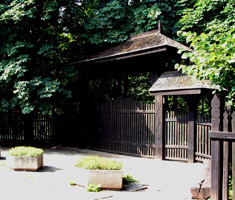
Founded in 1856 by the doctor and naturalist Anastasie Fatu, great patriot man of culture, it is the first botanical gardens in Romania. During that time it had several locations, but in 1963 was moved to its present headquarters, on Copou Hill.
With 100 hectares surface, the Botanical Gardens in Iasi include the sector of green-houses (with wonderful collections of tropical plants, cactuses, orchids and carnivorous plants), the rose garden (with over 800 species from all over the world), a recreational park with a lake.
Copou Park
 In 1834 Prince Mihail Sturdza decided to build the first public garden in Iasi, permitting access of all the inhabitants of the city. The garden was enlarged in 1849 and then in 1852, and in 1860 street lamps were installed here for the first time. The oldest monument in Romania, the Obelisk of the Lions, stands in the middle of the park. It was created by Mihail Singurov in 1834. On “Junimea” alley, bronze busts of the members of this well-known cultural organisation in Iasi can be admired.
In 1834 Prince Mihail Sturdza decided to build the first public garden in Iasi, permitting access of all the inhabitants of the city. The garden was enlarged in 1849 and then in 1852, and in 1860 street lamps were installed here for the first time. The oldest monument in Romania, the Obelisk of the Lions, stands in the middle of the park. It was created by Mihail Singurov in 1834. On “Junimea” alley, bronze busts of the members of this well-known cultural organisation in Iasi can be admired.
Roznovanu Palace (The City Hall)

Roznovanu Palace is the former residence of the Rosetti-Roznovanu family, built at the initiative of Iordache Neculai Roznovanu. It was inaugurated cu mare fast on 23rd April 1832 and at that time it was considered the most beautiful building in Iasi.
The master of the palace had 3 wives, and the last of them, Maria, was the one that opened the gates of the palace for musicians and literates.
Here George Enescu and Haricleea Darcle had concerts, and also here Mihai Eminescu read his poems, and the balls offered by lady Marghiolita were renowned in the whole region. In 1891, Vasile Pogor buys the palace from the Roznovanu family and establishes the headquarters of the City Hall.
During 1893-1894, the building undergoes several changes (an additional storey is built and the chapel is demolished) and it becomes for a short time the residence of the royal family (Prince Ferdinand and Princess Maria).During World War I, during 1916 – 1918, the Roznovanu Palace hosted the headquarters of the ministries and the political leaders refugees from Bucharest. In 1918, the Romanian War Council met in the present Conference Hall of the Local Council.
The building was restored after the fire in 1958 which destroyed almost completely the second floor and most of the ornaments on the first floor.
The administrative leadership of the city moves to the present headquarters again in 1969.
Today, in the former ball room of the Roznovanu family the meetings of the Local Council are held, as well as the great balls of the City Hall.



